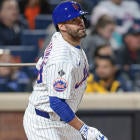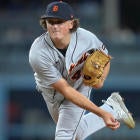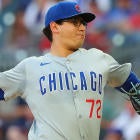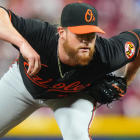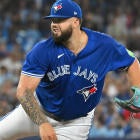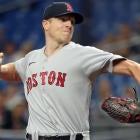Want to get a jump on the competition? Go to the CBS Sports app on your phone, open up "Settings" and sign up for Fantasy alerts to get the latest from our Fantasy baseball team as soon as it's available.
Ready to jump back into it? Well, here's your one-stop guide to what's trending in Fantasy Baseball.
The big questions. The most furious of position battles. The most curious of statistical outcomes. The timetables, both for injuries and prospect promotions. Basically everything you wish you knew but don't.
It's not a complete list, of course. Truth is there's probably a burning question for every player. But these are the 40 most pressing, the ones smoldering in the minds of mostest.
We'll begin at the end with No. 1 and work our way down ...
1. How long before we see Vladimir Guerrero and Eloy Jimenez?
The answer seems obvious. The game's best two hitting prospects -- both of whom go beyond typical top prospect standards in their ability to combine exceptional contact hitting with plus-plus power -- are on the Ronald Acuna timeline, meaning they'll be up in mid-April, the point when their respective teams will have secured an extra year of control. But no such assurances have been made, of course, and if you had asked me nine months ago when we might see these two, I would have said "by the end of 2018." Neither the Blue Jays nor the White Sox are playing for anything this year, so they could drag it out if they so choose. It's why Guerrero's Round 4 ADP is a little rich for me, even knowing the upside.
2. Is Adalberto Mondesi legit?
So many teams, particularly in standard 5x5 leagues, will sink or swim with this question. Mondesi has a one-of-a-kind quality that makes him too alluring to pass up in Round 3 or 4 of that format, but it's relying on half a season's data from a player with poor plate discipline and a shaky minor-league track record. Still, that 25-homer, 60-steal pace he was on ... whew. Playing for those run-with-reckless-abandon Royals, it makes him the odds-on favorite to lead the majors in that scarcest of categories, and the power actually began to manifest his past couple years in the minors. Meanwhile, his .335 BABIP, while high, isn't so far-fetched for a player with his speed and batted-ball profile. Even if he hits just .250, he's probably worth it.
3. Will the real Bryce Harper please stand up?
Lost in the hubbub over Bryce Harper's longer-than-expected free agency was the fact he, um ... wasn't so good last year. And in fact, it was the second time in three seasons that his numbers were less than first round-caliber. An injury was partly to blame for his 2016 numbers, but he was more or less healthy last season and suffered a similar fate, getting burned by a higher-than-typical strikeout rate and a lower-than-typical BABIP. It's worth noting, though, he regrouped to hit .300 in the second half, and you could point to 2015 and 2017 as years when he delivered MVP-caliber production with, yes, a better-than-.300 batting average. Grab him in the second round and he may turn out to be a top-five player, especially since his new home in Philadelphia is pretty sweet for hitters.
4. Is Jose Altuve on the decline?
At 28? It'd be a sad fate for player who produced at the level of Mike Trout and Mookie Betts the previous two years. Fortunately, there doesn't seem to be much truth to it -- not unless you ignore the fact he was playing through a fractured kneecap last year. It explains why he went from hitting .342 with seven homers and 12 stolen bases over the first three months to hitting .264 with six homers and five steals over the final three. Given that his batted-ball profile was virtually the same otherwise and he has long been a standout in two of the scarcest categories (batting average and stolen bases), he doesn't deserve to drop out of the first round or maybe even the top five.
5. Are health concerns behind Kris Bryant and Carlos Correa?
After looking like they'd be first-round fixtures for years to come, both played through nagging injuries last year -- Bryant to his shoulder and Correa to his back -- that compromised their production enough to drop them to Round 4 on average, which is a nice discount. But can we really trust they're better if their injuries were too vague to require medical intervention? Dr. Mike Tanner of RotoGraphs had a nice write-up explaining why an offseason of rest should do Bryant a world of difference, but coupled with the 27-year-old's inexplicable power loss in 2017, when he homered just 29 times, there's still risk. Correa, meanwhile, says he's back to full strength, but back injuries are of particular concern. Case in point ...
6. How much do Clayton Kershaw and Madison Bumgarner have left?
These legendary lefties have also seen their ADP decline with their production, but I'd hesitate to call it a discount. The underlying numbers suggest both are hanging by a thread, and for both, you can point back to an injury where it all started to unravel — for Kershaw, it was a herniated disc in 2016 and, for Bumgarner, a sprained shoulder in 2017. Each has been steadily losing velocity and saw his K/9 dip to its lowest mark in nearly a decade last season. The skills are rapidly diminishing, without much hope for a turnaround, and in Kershaw's case, there are clear workload limitations as well, as our old friend Dr. Tanner explains here.
7. Who's closing for the Brewers?
We could ask the same for the Diamondbacks, Braves, Phillies, Cardinals, Rays, Twins, White Sox and Royals, but the Brewers situation is the most intriguing. They have three relievers — Corey Knebel, Jeremy Jeffress and Josh Hader — who offer top-five potential in the role, but none is a clear front-runner after they split saves almost evenly last year. Knebel has been the most successful in the role, having delivered a brilliant 2017, but Jeffress was the first choice down the stretch last season and Hader might be the most talented of the bunch. Jeffress' health issues this spring may have swung the pendulum more in Knebel's direction, but there have been no official announcements.
8. Is the traditional closer on the outs?
Yeah, some of those teams that haven't declared a closer probably aren't going to settle on one. The Phillies, led by their traditions-be-darned manager Gabe Kapler, were at the forefront of this movement last year, so even though David Robertson is an experienced closer, he's most likely to work in the highest-leverage situation regardless of inning. The Braves could continue to play matchups between the right-handed Arodys Vizcaino and the left-handed A.J. Minter, and the Cardinals might do the same with Jordan Hicks and Andrew Miller. It puts a premium on the true dedicated closer, which might be offered by just two-thirds of the league, because they're the only ones you can trust for 30-plus saves — that is, as much as you can trust a closer for anything.
9. Will Francisco Lindor's timetable hold up?
As Jimmy Rollins once semi-famously said (and Josh Donaldson would probably second), calves are tricky cats, and when the initial timeline for this particularly calf strain is 7-9 weeks, it suggests a level of severity that could be rife with setbacks. Lindor was a slam dunk to go fourth overall prior to the injury, and you'd hate to downgrade that sort of upside out of the first round when the projected timetable has him returning at the start of April. But it's only a projected timetable. And is his upside the same if the Indians figure to play it cautiously with the calf, hindering the 25-steal potential he flashed for the first time last year? I might take a better-safe-than-sorry approach, given the depth at shortstop.
10. Is first base as weak as looks?
Aside from catcher and second base, which are traditionally weaker positions, yeah, first base is about as weak as it gets. Now, that's partly because four of the five most trusted at the position — Freddie Freeman, Anthony Rizzo, Joey Votto and Jose Abreu — had off years, and all seem like reasonable bets to bounce back in 2019. It also gets deeper further down the position, meaning if you play in leagues of significant size, first base is a position you can ably fill late. But standard mixed-league owners will want to make it a priority early, whether by targeting Paul Goldschmidt or Freeman in Round 2 or settling for Votto or Abreu in Round 6. You don't want to be the guy pinning your hopes on a Miguel Cabrera bounce-back.
11. Where else are the steals coming from?
They're mostly scattered throughout the early rounds. Of the 15 players who had 25-plus steals last year, eight are among the first 50 players drafted. One reason the category seems so dire is because the tried-and-trues didn't deliver up to expectations last year, and while Dee Gordon doesn't seem as likely to rebound as Billy Hamilton, he could bring you 40 steals at a bargain. His new teammate in Seattle, Mallex Smith, was one of just three players to steal 40-plus last year and would seem to have good job security, and we already know about Jonathan Villar. If he can secure the starting second base job in Colorado rookie Garrett Hampson has big steals potential, particularly given his uncommon on-base potential, and projected Indians left fielder Greg Allen stole 21 bases in 91 games a year ago. Apart from those fine contributors, you'll probably have to cobble together a dozen here and a dozen there.
12. Will the Royals have the majors' top three base-stealers?
Well, they had the majors' leading base-stealer a year ago in Whit Merrifield, and if you project Adalberto Mondesi's half-season stats over a full season, he would have been a distant first in the category. Factor in the signing of Billy Hamilton, who was long regarded as the pre-eminent base-stealer in the majors, and you can see what the Royals are going for here. Get Michael Ian Black on the phone because they love the 80s. When you don't have the personnel in place for a modern power-soaked offense, you have to manufacture runs, and they certainly have the personnel, not to mention a proven ambition, for that. Hamilton's steals decline last year seemed mostly like a coaching decision, so it's safe to assume 50-plus is back on the table for him.
13. Is Alex Reyes still destined to start in the big leagues?
Through various ailments, Reyes has remained at or near the top of pitcher prospect lists, and he's already semi-proven at the big-league level, having put together a 1.44 ERA and 9.7 strikeouts per nine innings over 50 innings dating back to 2016. But a quick glance at the Cardinals depth chart suggests he won't be getting the benefit of the doubt after following up a lengthy recovery from Tommy John surgery with a season-ending lat injury. The potential outcomes range from winning a rotation spot to winning a bullpen spot to opening the year in extended spring training, thereby saving those bullets for later, to getting hurt again, which is a wild way to invest a mid-round pick. And judging by this report, his fate may ultimately be tied to that of Carlos Martinez.
14. How much better can J.T. Realmuto get?
Kind of have to use Christian Yelich as the basis for comparison here, right? After all, his home/away splits showed his power was suppressed at Marlins Park, but then after landing in a more hitter-friendly venue, boom, league MVP. Crazy thing is Realmuto's home/away splits were even more pronounced with the Marlins, as you'll observe:
Home BA | Home HR | Home OPS | Away BA | Away HR | Away OPS | |
2016 | .250 | 3 | .643 | .352 | 8 | .893 |
2017 | .227 | 5 | .633 | .317 | 12 | .897 |
2018 | .269 | 8 | .773 | .283 | 13 | .870 |
Career | .245 | 22 | .678 | .309 | 37 | .848 |
Granted, it's never as simple as projecting the road numbers over a full season, and rarely in these situations does it play out as palpably as Yelich's 2018. But judging by the batted-ball data, an optimistic scenario has Realmuto hitting something like .290 with 30 homers, making him well worth the price of admission.
15. Is Ronald Acuna already MVP material?
Ready or not, he's being drafted like it, going off the board 10th overall on average, with many smart Fantasy Baseball analysts claiming he should go even higher than that. It's a stunningly optimistic outlook for a player with less than a full season under his belt, owed in part to his top-shelf pedigree, the scarcity of stolen bases and a completely bonkers second half. The potential outcomes range from Mike Trout to Justin Upton, so any way you look at it, you're getting a productive player. But the steals likely won't be so plentiful if he's batting cleanup as projected, and those second-half numbers were partly built on an inflated BABIP. Plus, sophomores just slump sometimes. You can catch the league by surprise only once.
16. Will Trevor Story's gains hold?
The key to Story's metamorphosis from flawed power bat to second-round stud was twofold: he drastically reduced his strikeouts, allowing the BABIP-inflating effects of Coors Field to do what they do, and he inexplicably began stealing bases. But as we saw with Giancarlo Stanton last year, strikeout gains aren't always permanent, and seeing as stolen base totals are largely a matter of deciding to run, nothing's stopping him from stopping just as suddenly. Story's 2018 numbers all fit nicely together, suggesting it wasn't all good fortune, but it may not be the new normal for him. Still, a potential five-category stud is tough to pass up at any sort of discount, be it only a round or two.
17. Are Christian Yelich's numbers in any way sustainable?
The best part about a profile like Yelich's, which combines a little of this and a little of that into a full-fledged superstar, is that it's virtually bust-proof. Too much would have to go wrong take him down. He was 22 for 26 in stolen bases last year, so you can bet the Brewers won't be asking him to curtail that part of his game. He takes his walks, which ensures he'll score bunches of runs batting near the top of a deep lineup. He makes contact at a high rate and with a batted-ball profile that lends itself to a high BABIP, so the .300 batting average is probably here to stay. By the time you're asking if his outlier home run-to-fly ball rate will happen again, he's a borderline first-rounder already.
18. Is Corey Seager still the player we want him to be?
The prognosis is positive for any player coming back from Tommy John surgery, but especially a position player, with AL Rookie of the Year finalist Gleyber Torres serving as the latest example last year. But a couple key differences: Seager is also returning from arthroscopic surgery on his hip, which may have less predictable effects, and he's returning to a shortstop position made much deeper by the emergence of Alex Bregman, Javier Baez, Trevor Story, Xander Bogaerts and Torres himself. Much of the enthusiasm surrounding Seager previously was in relation to what he could became given his high contact and line-drive rates at such a young age and such a weak position, but in a 2019 context, he's not established enough to take before Round 5 or so.
19. Will Yasiel Puig return to stardom with the Reds?
It seems like ancient history now, but the numbers Puig put up as a rookie in 2013 and a sophomore in 2014 had him positioned among the Fantasy elite, so finding himself in new surroundings while still in the prime of his career has to feel like second life. It has a little something to do with the fact the Reds play in one of the league's hitter-friendliest ballparks, of course. But more than that, it's about the way the Reds figure to use him, positioning him like the middle-of-the-order bat he was born to be rather than a seventh- or eighth-place hitter who's lucky to get 500 at-bats in a season. Factor it all in, and a 30-plus homer, 20-plus steal season is firmly on the table.
20. What went wrong for Brian Dozier?
That's the thing: There's nothing in his batted-ball profile to validate the drop in production. In six months' time, the guy went from being a third-round pick in Fantasy to the last bat off the Dodgers bench, and he did it with virtually the same walk rate, strikeout rate, line-drive rate, fly-ball rate, pull rate and hard-hit rate. He's 31, so it's possible he took the quick path down the aging curve, but usually in those situations it manifests in some other way. He has historically saved his best work for late in the season, but he ended last season on a Dodgers team with big aspirations and ample alternatives. They couldn't wait around for him, in other words, but now that he's going in Round 12 on average, maybe you can?
21. How concerning is Alex Bregman's elbow?
How 'bout not at all? That's what Dr. Mike Tanner of RotoGraphs had to say when the Astros announced their latest homegrown MVP candidate underwent surgery to remove loose bodies from his elbow in January, and my recollection of players who've had the same procedure tells me the same. It's straightforward unless it isn't, in which case it's a contributing factor to ligament damage, and that's clearly not in the discussion here. With the addition of middle-of-the-order power to an already tremendous contact profile, Bregman should be a slam-dunk first-rounder, and if this injury allows him to slide, all the better.
22. Will "the opener" become the norm?
The Rays were mainly the ones pioneering this strategy last year, but the Twins flirted with it at times and the Athletics used it in the postseason. While we could argue the merits of depleting the bullpen by one so early in a nine-inning contest, the results were at least promising enough to compel other teams to add it to their vernacular, with the Pirates, Blue Jays and Giants all making overtures this offseason. So far, only fringy pitchers like Yonny Chirinos and Ryan Yarbrough have been impacted, and it wouldn't make sense to bottle up aces against the top of the lineup. Still, in leagues that reward quality starts, this approach could disrupt starting pitcher depth if it becomes widespread.
23. How will the Dodgers distribute playing time?
Manager Dave Roberts is already on the record saying the Dodgers will platoon less this year, which is a promising development after they used that strategy to excess last year. The most egregious example was Max Muncy, arguably the team's best hitter, who actually had better numbers against lefties when they resorted to platooning him in August. He could be an OPS monster, maybe a better Anthony Rizzo with full-time at-bats. Others like Chris Taylor and rookie Alex Verdugo would surge up Fantasy rankings with the promise of everyday play, but so far, Roberts has only specifically excluded Corey Seager and A.J. Pollock from platoon duty.
24. Can we trust in the Rockies starting rotation?
Ranking fourth in bWAR last year, behind only Aaron Nola, Jacob deGrom and Max Scherzer, was Kyle Freeland, who delivered a 2.85 ERA over 202 1/3 innings. German Marquez, meanwhile, was one of the best in the second half, putting together a 2.61 ERA, 1.00 WHIP and 12.0 K/9. And then there's Jon Gray, who may still be the most talented pitcher in club history even if he has only shown it in flashes. Investing in them is dubious because Colorado's mile-high environment has a long history of destroying talented arms, and in the case of Freeland, who accomplished what he did despite ordinary strikeout, walk and ground-ball tendencies, your hesitance is warranted. But Marquez's strikeout ability and stuff were so overwhelming once he got his release point figured out that he's worth the gamble.
25. How committed are the Yankees to Luke Voit?
They say he has a leg up on the starting first base job this spring, as well he should after completely flipping the script at the position when the Yankees acquired him from the Cardinals last July. His 14 home runs in two months' time demonstrated a power ceiling that wasn't always evident in the minors, where his line-drive swing lent itself more to a high batting average. The best-of-both-worlds scenario is an enticing one but easily squashed if MIguel Andujar becomes too much of a liability at third base, Gary Sanchez becomes too much of a liability at catcher or Greg Bird wins back hearts and minds this spring. And if Brian Cashman lands Manny Machado, all bets are off.
26. What about the Mets to Peter Alonso?
Brodie Van Wagenen spent his first offseason as Mets general manager stockpiling infielders, which would seem to challenge the idea that Alonso's day as the team's regular first baseman is nigh. But in this case, Van Wagenen's words may speak louder than his actions. He's on the record saying Alonso is his choice to start on Opening Day, and why not? The 24-year-old with true 80-grade power broke out in a big way last year, hitting 36 homers while reaching base at a .395 clip. Dominic Smith and Astros castoff J.D. Davis may fend him off early in a bit of service time manipulation, but hopes of a late-April arrival should earn Alonso mixed-league looks at a weak position.
27. Are we overlooking Yu Darvish?
Considering he was drafted alongside aces from the time he debuted in 2012, seeing Darvish slide to the Round 14 range is indeed jarring, but perhaps it's to be expected coming off season that began with a 6.00 ERA in six starts and ended with elbow surgery. It's what happened in between that captures my attention, though. In what turned out to be his final two starts, he allowed two runs on five hits with 12 strikeouts in 10 innings, seemingly correcting the release point that made his fastball so hittable early. It's not like the velocity was suffering, after all. If he looks right this spring, I suspect his ADP will skyrocket.
28. Is there any upside to be found at catcher?
"Unless you count catcher as a position" is a qualifier I often use on the Fantasy Baseball Today podcast when comparing the relative strength of positions because it goes without saying it's the weakest. There are built-in disadvantages for anyone who dares don the tools of ignorance, such as regular rest, frequent injury and often a short shelf life, so it stands to reason organizations would move their best bets off the position in the minors, creating a sort of stasis at the top. But a couple of legit prospects are on the verge of breaking through, with Danny Jansen looking like the odds-on favorite in Toronto. Francisco Mejia probably would be in San Diego if not for Austin Hedges' terrific defense, but the upside is still worth the gamble. Carson Kelly, though not as hyped, has the inside track in Arizona and could surprise.
29. Do Jesse Winker, Franmil Reyes and Jeff McNeil have paths to playing time?
They were three of the most exciting performers as their time in the majors drew to a close last year, so naturally, their teams have made painstaking efforts to squeeze them out in 2019. In fairness, Winker is recovering from shoulder surgery, so there's some prudence to having Matt Kemp on hand as a fallback plan. Then again, there's also this Nick Senzel-to-the-outfield nonsense to figure out. Wil Myers kind of put Reyes in a tough spot by declaring himself an outfielder from now on. The Mets, meanwhile, have infielders coming out of their ears, but an injury to Jed Lowrie has McNeil ticketed for third base at the start, with an ultimate goal of transitioning him to left field. The uncertainty for these three only solidifies their sleeper appeal by keeping the masses lukewarm on them, and in the end, talent usually wins out.
30. Will Jimmy Nelson pick up where he left off?
He was quickly emerging as the sort of bat-missing workhorse who dominates the top of the starting pitcher rankings in 2019, and then he tore the labrum in his pitching shoulder sliding back into first base on a single gone greedy. A torn labrum is what cost a skyrocketing Michael Pineda a couple miles per hour on his fastball at the start of his career. It more or less ended the careers of Brandon Webb, Erik Bedard, Mark Prior and Mark Mulder. It's really bad news. Granted, Nelson's was a partial tear rather than full-blown, but he'll begin the year on the IL as he works to build up his innings.
31. How will the Braves work in all their young arms?
Beyond the presumptive top four of Mike Foltynewicz, Julio Teheran, Kevin Gausman and Sean Newcomb, the Braves have a rotation's worth of pitching prospects competing for the final spot. Injuries have helped with the logjam a bit. Foltynewicz (elbow) is looking at an IL stint to begin the season, which likely opens the door for Touki Toussaint as well as spring standout Kyle Wright. Mike Soroka will be in the discussion once he gets past his latest bout with shoulder soreness, and Max Fried, Bryse Wilson and Luiz Gohara are still lurking.
32. Will the Rockies finally give the kids a chance?
The Rockies have an unfortunate history of blocking exciting up-and-comers with boring old veterans. Just ask anyone who bought into David Dahl and Ryan McMahon the past couple years. But the tide may finally be turning this year with the coronation of Garrett Hampson as the team's starting second baseman. Anyone who gets at-bats at Coors Field is of interest to Fantasy owners, but particularly someone who combines on-base skills with proven base-stealing ability. Dahl himself looks like a fixture in right field after performing at a 30-homer pace as a part-timer last year. Of course, McMahon doesn't have an opening, not unless new first baseman Daniel Murphy goes down, and there's still Brendan Rodgers looming. But it's progress.
33. Just what kind of pitcher will Yusei Kikuchi be?
A quick glance at Kikuchi's NPB numbers shows a pitcher who averaged less than a strikeout per inning and only recently overcame some pronounced control issues. But didn't we have the same complaints about Miles Mikolas when he came over from that same league a year ago? The game plays differently in different parts of the world, but Kikuchi's arsenal -- in particular his slider -- suggests he should be a pretty good bat-misser, offering a strikeout rate more in line with Kenta Maeda. Whether he's durable enough to hold up for a full season remains to be seen, but he's efficient enough to throw six-plus innings with consistency. He's no ace, but there's top-30 upside.
34. Where and when will Nick Senzel play?
Considered close to big-league ready from the time the Reds drafted him second overall in 2016, Senzel has yet to set foot in the majors in part because they still haven't found a position for him. He's a natural third baseman, but recent breakout Eugenio Suarez is locked in there. They've tried him at second base and shortstop, where there isn't a clear path for him either. So now, center field is the goal, and it's more or less free with Billy Hamilton out of the picture. Then again, Yasiel Puig's name has also come up there, and the Reds have to find at-bats for Scott Schebler somehow. Still, if Senzel can avoid his past health issues -- such as a recurring bout with vertigo -- this year looks like his best chance yet.
35. How will the Astros make room for Kyle Tucker?
It seemed like the natural progression in the Astros' procession of talent. Evan Gattis and Marwin Gonzalez would depart for bigger salaries elsewhere, and Tyler White and Kyle Tucker would step in to take their place. But then the Astros went and handed big free-agent dollars to Michael Brantley, renewing the logjam. Of greatest concern is Tucker, one of the game's top hitting prospects who seems to have accomplished all he can at Triple-A, where he hit .332 with 24 homers, 20 steals and a .989 OPS last year. But while White deserves one last look after finishing last season on a tear, he's no sure thing. Likewise, Yuli Gurriel and Josh Reddick are less than first-division regulars. Rest assured, a path will open for Tucker.
36. Does Miguel Cabrera have anything left?
After being a model of health for more than a decade, Cabrera has been ravaged by injuries the past four years, peaking last year with a ruptured biceps tendon that cost him all but 38 games. Combine that with the groin tear and herniated discs he played through in 2017, and it's fair to assume his reduced production isn't just a matter of declining skill. In fact, his plate discipline numbers are as impressive as ever, and his line-drive and hard-hit rates still rank among the best in the league. If he gets more time at DH, as expected, maybe it does for him what it's done for Nelson Cruz in the twilight of his career.
37. Will Ross Stripling and Julio Urias get their shot with the Dodgers?
One is a returning All-Star, the other a top pitching prospect fresh off injury. Neither has a spot in the starting rotation or even a clear hope for one. Yes, even after moving Alex Wood this offseason, the Dodgers are still overrun with rotation redundancies. Who would you remove between Clayton Kershaw, Walker Buehler, Hyun-Jin Ryu, Rich Hill and Kenta Maeda? Then again, these are the Dodgers. We kind of know how they operate by now. Aside from maybe Buehler, each of those five figures to require a DL stint at some point and may get another just to build in some rest. So Stripling and Urias will get their chances; they'll just be sporadic and unpredictable. Doesn't help much on Draft Day, does it?
38. How will the Astros rotation shake out?
The Astros have an unmatched track record of maximizing the output of whatever castoff pitcher they take a shine to, which is why you can't fault the Wade Miley signing too much. He looks like a total snoozer, though, compared to what else they have competing for the spots vacated by Dallas Keuchel and Charlie Morton. Josh James upped his fastball velocity by 10 mph last year, combining it with a well-refined secondary arsenal for big strikeout numbers, and Framber Valdez looks like a ground-ball specialist on the level of Keuchel himself. But it looks like Brad Peacock, a reliever last year who did some impressive work as a starter in 2017, has the early edge, partly because James got hurt.
39. Can Jesus Luzardo break camp with the team?
The Athletics have said they'll give him an honest shot, even if it's far-fetched and possibly self-defeating for a 21-year-old who threw only 109 1/3 innings last year to begin contributing so early in the season. He's only a couple years removed from Tommy John surgery, after all, and appeared to wear down over his final three starts last year. Still, the stuff is there for him to make an impact this year. He rode a high-spin fastball and knee-buckling changeup to a 2.01 ERA, 0.97 WHIP and 10.7 K/9 over his first 20 starts last year and is the odds-on favorite to be this year's Walker Buehler, who himself had innings concerns at the start of last year.
40. Is Jonathan Villar faking us out again?
It was only a few years ago that Villar's league-leading 62 steals were considered too scarce to pass up early in drafts. What we didn't account for was just how little it would take for him to lose his job the following year, when he still contributed perfectly usable home run and steals totals but became a liability for his inability to get on base. Granted, these Orioles don't have as much to lose as those Brewers did, but they also don't have a real investment in Villar, who's more of a space-filler than a building block. It wouldn't take much of a slump for them to start experimenting at second base, and it wouldn't take much of an offer for them to trade Villar to a team that may not have so many at-bats to spare.














